Mastering the Art of Sock Drawer Organization
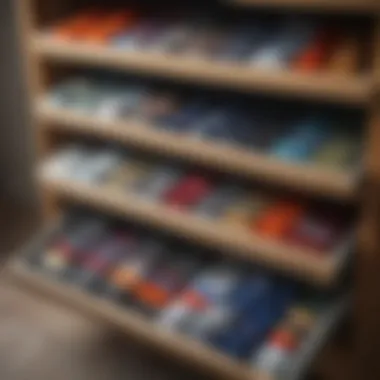

Intro
Organizing a sock drawer might seem like a small task, but it has a significant impact on your overall home organization. A tidy and systematic approach can not only save time but also reduce stress. This guide explores various methods to optimize your sock storage, offering actionable insights and techniques that can be easily implemented.
Key Insights and Trends
While sock organization often takes a backseat in interior design, it reflects broader trends in minimalism and efficiency. The current focus is on creating functional spaces. Many homeowners are prioritizing strategies that enhance comfort and accessibility. With that in mind, consider how a well-organized sock drawer contributes to a more harmonious living area.
"An organized space leads to an organized mind."
Practical Tips and How-To Guides
Effective sock organization begins with sorting. Start by emptying your drawer completely. This gives you a clear view of what you have, allowing you to declutter. Here are some practical steps to implement:
- Sort by Category: Group socks into categories such as dress socks, athletic socks, and casual wear. This makes it easier to find what you need.
- Assess Condition: Check for wear and tear. Discard any socks that no longer match or have holes. A cluttered sock drawer holds onto things you don't use, making organization hard.
- Choose Storage Solutions: Select organizers that fit your drawer. Consider using dividers or small bins to keep categories separate. Look for clear or labeled bins for easy identification.
- Maintain Regularly: Set a schedule to clean and reorganize your sock drawer every few months. This ensures that it remains tidy and functional.
Using these methods, you can transform a chaotic sock drawer into an efficient and aesthetically pleasing space.
Understanding the Importance of Organization
A well-organized sock drawer is not just an aesthetic upgrade. It serves as a fundamental element in maintaining overall order in your home. While some may view this task as trivial, the organization of small spaces contributes significantly to larger aspects of living environments. This section delves into why having a sock drawer that is neatly arranged is essential and how it can positively influence various areas of your life.
Why a Sock Drawer Matters
Maintaining a sock drawer that is organized can lead to numerous benefits. Firstly, it saves time. When socks are placed back into a drawer without any discernible order, finding a matching pair can become a daunting task. Conversely, when socks are categorized and stored properly, locating them becomes both efficient and fast. This time-saving attribute can be crucial in hectic morning routines or when preparing for a specific occasion.
Moreover, an organized sock drawer enhances clarity in the mind. The sight of chaos can lead to feeling overwhelmed or stressed, especially when you are in a rush. A well-arranged drawer provides a sense of calm, inspiring you to approach your daily rituals with a more disciplined mindset.
Impact on Daily Routines
The effects of sock drawer organization extend far beyond just tidiness. When you know where things are, you can plan better for your day. Established routines become smoother and more predictable. For homeowners and busy professionals, this efficiency can mean the difference between a frantic start and a relaxed one.
In addition, effective organization can promote a culture of cleanliness throughout the home. When you prioritize organizing smaller spaces like sock drawers, it sets a precedent for the rest of the household. It communicates the importance of maintaining order, reinforcing good habits among family members.
"An organized space can influence not just aesthetics but also emotional well-being and productivity."
The physical act of organizing, especially in a drawer that often goes overlooked, has implications that ripple through your daily life. Whether you are a homeowner looking to streamline your environment, or simply someone who desires a bit of order, understanding the importance of sock drawer organization is the first step in that journey.
Assessing Your Current Sock Collection
Assessing your sock collection is a crucial stage in the journey to an organized drawer. By understanding the current state of your socks, you can make informed choices about what to keep, toss, or replace. This step creates a foundation for a more effective sorting and organizing process. Knowing exactly what you own allows you to avoid unnecessary purchases and streamlines future selections when you need a new pair.
Inventorying Your Socks
Start by gathering all socks from different locations, including the drawer, laundry baskets, and any hidden spots. Lay them out in a large area, such as a bed or floor, for a clear view. This allows you to take stock of what you have. When inventorying your socks, consider sorting them into categories such as:
- Casual socks
- Dress socks
- Sports socks
- Winter socks
This method not only helps to visualize your collection but also highlights duplicates or socks that no longer match with a partner. An inventory process encourages reflection on how often you wear each type, guiding future organization based on practicality and frequency of use.
Identifying Worn or Unused Pairs
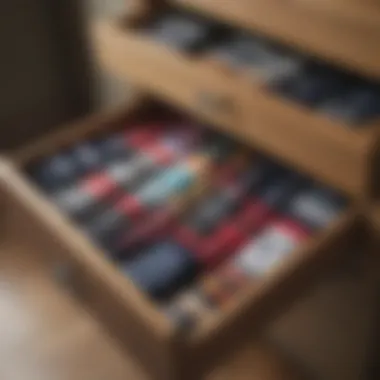
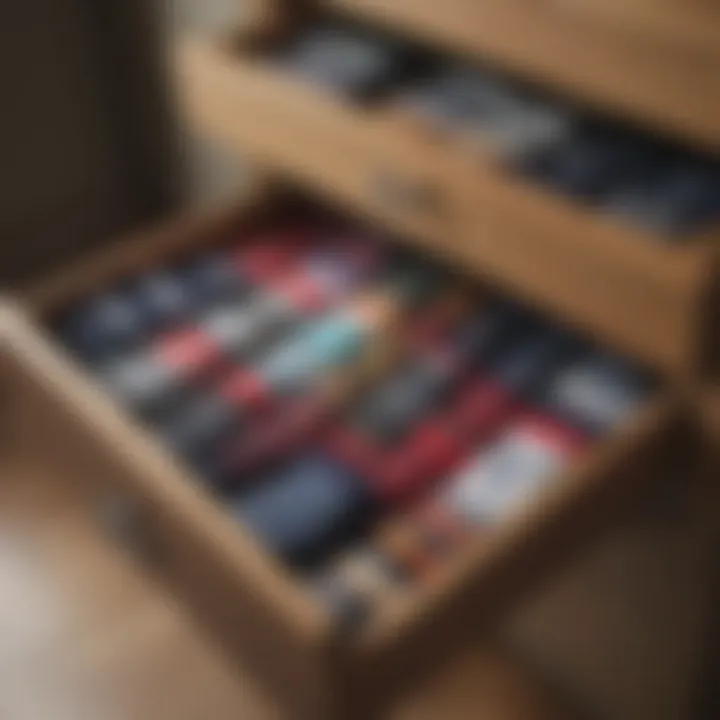
Once you have completed your inventory, it’s important to identify which pairs are worn out or seldom used. This stage is essential to declutter effectively and maintain a useful sock collection. Socks that show signs of wear—characterized by fading colors or holes—should be considered for disposal. Furthermore, ask yourself if certain pairs have not been worn in a long time, questioning their necessity in your collection.
Criteria for Disposition
When deciding on the criteria for disposition, consider factors such as:
- Condition: Assess if the socks are too worn or damaged for any further use.
- Frequency of Use: Think about how often you have worn them in the past year.
- Practicality: Determine if they fit well into your lifestyle.
These criteria enable a more systematic approach to decluttering. Disposing of unnecessary items contributes to a more organized environment, ultimately making your sock drawer more functional.
Considerations for Replacing Pairs
If you find a number of socks that need replacing, it is wise to think about considerations for replacing pairs. Ask yourself:
- Need: Do you have enough socks for different occasions?
- Quality: Consider investing in higher quality socks that offer durability over time.
- Style: Check if you prefer certain colors or patterns.
Assessing the need for replacements ensures that you are enhancing your collection rather than just filling it. It fosters a thoughtful approach to purchasing socks that truly align with your wardrobe.
Ultimately, assessing your current sock collection prepares you for effective organization, making subsequent steps much more manageable and rationale-driven.
Choosing Storage Solutions
Selecting appropriate storage solutions is a critical step in achieving an organized sock drawer. The right containers can significantly influence how well your socks are sorted and maintained. This section explores various types of storage containers and the considerations that come into play when choosing materials and sizes.
Types of Storage Containers
Drawer Dividers
Drawer dividers serve as an effective organizational tool within your sock drawer. They create separate sections, allowing you to easily categorize and access your socks. One of the key characteristics of drawer dividers is their versatility; they come in different sizes and materials to suit a variety of drawers. This is a popular choice because it maximizes the use of space while keeping everything neatly in place.
One unique feature of drawer dividers is their adjustable design. This means you can adapt the divider size to fit your specific drawer dimensions. The advantages of using drawer dividers include improved visibility of your sock collection and reduced clutter, making it easier to find what you need. However, a potential disadvantage is that some dividers might not be sturdy enough, leading to shifting over time.
Bins and Baskets
Another option for organizing socks is using bins and baskets. These containers can be placed on top of a dresser or inside a closet. The key characteristic of bins and baskets is their capacity to store not only socks but other items as well, offering flexibility in organization. This makes them a beneficial choice for a multifaceted approach to home storage.
A unique feature of bins and baskets is their aesthetic appeal. They often come in various designs and materials, which allows you to enhance the decor of your space while keeping things tidy. The advantages include portability and easy maintenance; you can simply lift the bin out when you need to dig through your socks. However, they may require more space compared to drawer dividers, which could be a disadvantage in smaller rooms.
Selecting Materials and Sizes
When it comes to selecting the right materials and sizes for storage solutions, several factors must be considered.
Durability Considerations
Durability is a crucial factor in the longevity of any storage solution. The right materials can withstand wear and tear, ensuring your sock storage remains intact over time. A key characteristic of durable materials, such as high-quality plastic or wood, is their capacity to resist damage from repeated use. This makes them a solid choice for those looking to invest in long-lasting organization solutions.
Unique features of durable materials include resistance to moisture and ease of cleaning. These advantages help maintain the quality of the socks stored, preventing any potential damage. On the flip side, durable materials often come at a higher price point, which could deter some from considering them.
Space Efficiency
Space efficiency is an essential aspect of any organization strategy. The right storage solutions should effectively utilize available space while allowing easy access to contents. A key characteristic of space-efficient solutions is their design, which maximizes storage without sacrificing aesthetics or functionality. This is increasingly beneficial in smaller living spaces where every square foot counts.
Unique features of space-efficient designs include modular elements, allowing for customization based on personal needs. The advantages lie in their ability to adapt to changing sock collections over time, making them a practical choice. However, space-efficient solutions may sometimes sacrifice capacity for compactness, possibly requiring you to sort or rotate your sock collection more frequently.
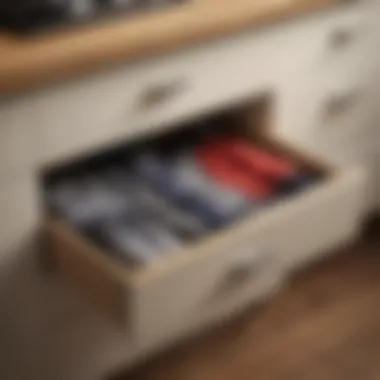
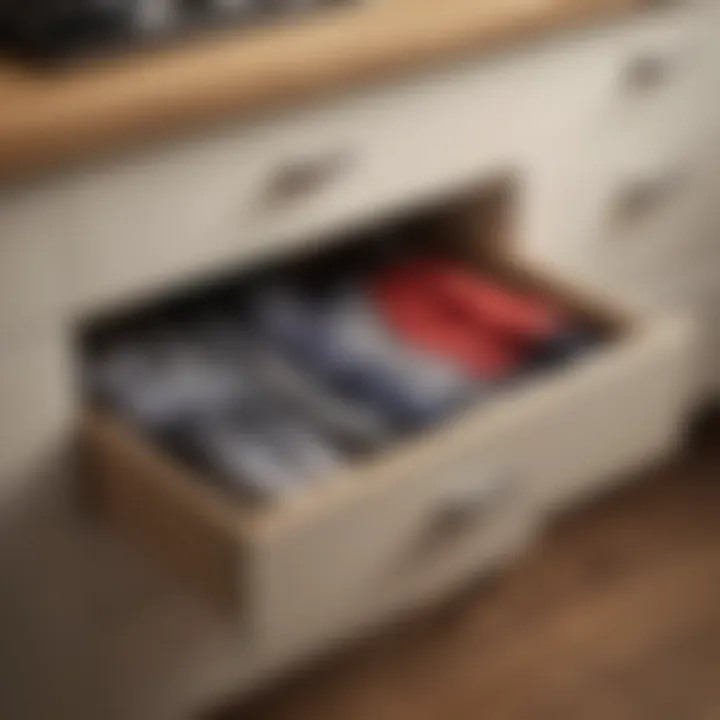
Effective Sorting Techniques
Sorting techniques are key to achieving a well-organized sock drawer. They provide clarity on what socks you own and how best to access them. Implementing organized sorting methods saves time and frustration during your daily routine. When socks are sorted effectively, it enhances the overall efficiency of your dressing process and contributes to a clutter-free environment.
Categorization by Type
Casual vs. Formal Socks
Casual and formal socks serve distinct purposes in your wardrobe. Casual socks tend to be more relaxed in style and comfort. They often come in various fun patterns and colors, making them an excellent choice for informal settings. On the other hand, formal socks are typically made from high-quality materials, designed to complement dress shoes and attire. Their key characteristic is the subdued color schemes, often in black, navy, or gray.
The benefit of separating these two types is significant. Keeping casual socks with casual ones allows for quick selection while getting ready. Many find that this thematic categorization streamlines both the morning routine and the overall aesthetic of the drawer. However, it can lead to extended space usage since formal styles may occupy more room due to their typically longer length.
Seasonal Sorting
Sorting socks seasonally ensures that you are prepared for various weather conditions throughout the year. Winter socks, often thicker and warmer, should be stored separately from lighter summer options. This approach minimizes confusion and clutter.
The main advantage of seasonal sorting is efficiency. For example, having easy access to winter socks during the colder months means you won't waste time searching through summer styles. However, this method may require some extra management, as it involves swapping socks in and out of the drawer with the changing seasons.
Color Coding for Quick Access
Color coding is a straightforward technique that quickly enhances accessibility and visual appeal. By organizing socks based on color, you minimize the mental effort needed to locate specific pairs. Each category becomes easily recognizable at a glance, allowing for rapid selection.
This approach also adds an aesthetic element to the drawer. A neatly arranged spectrum of colors can bring a sense of order and tranquility to an otherwise mundane task. However, a drawback may arise if one has many similar shades, which can complicate identification.
Pairing Strategies
Pairing socks smartly can increase the overall efficiency of your drawer. This is done through methods that keep pairs together while maximizing space.
Folding Techniques
Folding techniques play a critical role in maintaining organization. A popular method involves folding one sock into the opening of its pair, creating a compact and tidy arrangement. This practice not only saves space but also reduces the risk of losing pairs. Moreover, it offers an efficient display of socks, making selection easier during hurried mornings. Some may argue that folding consumes more time. However, the long-term benefits usually outweigh the initial investment in time.
Using Clips or Bands
Using clips or bands keeps socks paired even when they are not stored in a conventional way. By securing pairs with a small clip or elastic band, you can prevent them from getting separated. This method is especially effective for those with many pairs and limited drawer space. The main advantage is that it simplifies finding matching pairs while keeping your drawer tidy. On the downside, some people might find clipping or banding their socks cumbersome. However, it proves to be a viable strategy for ensuring pairs stay together.
Implementing the Organization
Implementing organization within your sock drawer is crucial for creating a functional and aesthetically pleasing space. This step moves beyond merely sorting and storage; it focuses on how to harmoniously arrange your socks so that they are both accessible and visually appealing. A well-organized drawer facilitates easier choices during your daily routines, reducing the time spent searching for the right pair and allowing you to dress efficiently. Additionally, implementing organization can enhance the lifespan of your socks by avoiding unnecessary wear caused by haphazard stacking.
Arranging Socks in the Drawer
The arrangement of socks in the drawer requires consideration of both accessibility and visual order. Start by placing frequently worn items in the forefront. Casual socks may occupy the prime locations since they tend to be used more often than formal options. Next, consider categories such as colors or patterns. Using drawer dividers will help maintain separation between these categories, preventing the socks from intruding into each other's space. This not only promotes visibility but also aids in reducing clutter.
For practical arranging techniques, you might try:
- Vertical stacking: Arrange socks vertically so that you can see all pairs at once. This can be particularly effective if you use a shallow drawer.
- Rolling socks: Some individuals prefer rolling in pairs, which can save space and reduces wrinkles.
- Grouping similar styles: For instance, place all ankle socks together apart from knee socks.
Data indicates that a methodical arrangement can lead to long-term satisfaction with your organization system.
Maintaining Easy Access
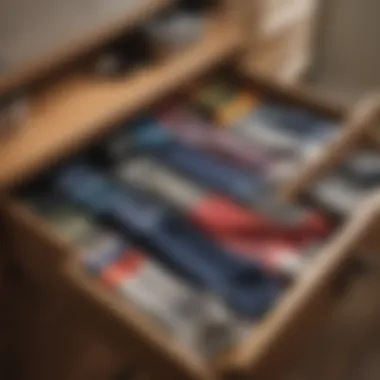

Once your socks are organized, maintaining easy access is essential to sustaining that organization in the long run. The goal is to ensure that accessing your socks does not become a chore. One effective approach is to implement a one-in, one-out policy; for every new pair of socks, consider disposing or donating an old pair. This helps to prevent overcrowding in the drawer due to new acquisitions.
Consider these important factors for maintaining easy access:
- Routine checks: Periodically assess the drawer to ensure everything stays in its designated place. This can be tied into your weekly home maintenance routine.
- Adjustments based on usage: If you find certain pairs are worn more frequently, don’t hesitate to rearrange them into more accessible spots within the drawer.
- Consistent folding or rolling technique: Adhering to the type of organization you chose initially will promote familiarity, thereby making it easier to return socks to their rightful places after laundry.
Implementing an organized system for your sock drawer is more than a mere aesthetic concern; it is a practical decision tied directly to efficiency and ease of use. As individuals and families evolve, so too should the methods that support their daily life. This ensures that every sock has a place, leading to a more harmonious and organized living space.
Remember, a well-maintained sock drawer reflects a commitment to personal organization and simplifies everyday life.
Tips for Maintenance and Longevity
Maintaining the organization of your sock drawer is just as essential as the initial sorting and storage processes. Effective maintenance ensures that your orderly system remains functional and visually pleasing over time. Regularly revisiting your drawer allows you to adapt to changes in your sock collection and keeps clutter at bay. This section provides practical strategies to ensure your sock drawer continues to serve you well.
Regular Audits
Conducting regular audits of your sock collection is vital for ongoing maintenance. It helps you assess which socks are still in good condition and which ones should be disposed of. Ideally, this should be done every few months.
When you perform an audit:
- Examine each pair for signs of wear and tear. Look for holes, fraying, or discoloration.
- Count your pairs. Ensure you have matching socks. Any pairs that seem lost should be dealt with, either by finding their match or by deciding to remove them.
- Evaluate your needs. Determine if your lifestyle has changed. Have you started exercising more, requiring specific types of socks, or perhaps moved to a region with different weather conditions? Adjust your collection as necessary.
Replacing Worn Out Items
Worn out socks shouldn't clutter your drawer any longer. Keeping unfit items can lead to frustration when you want a good pair. Replacing these socks not only keeps your drawer looking great but maintains function and comfort. Established criteria for when to replace socks can guide you:
- Frequency of Use: If you wear a specific pair often and they show clear signs of wear, it's time for replacements.
- Physical Health: Old socks that lack support or cushioning can lead to foot issues over time. Don't compromise on comfort.
- Fashion Consideration: Sometimes, it's simply about personal style. Outdated designs or worn colors may push you to buy new socks that reflect current tastes.
Adapting to New Additions
As your wardrobe evolves, so will your sock collection. New purchases or gifts can alter the dynamic of your drawer. It’s crucial to regularly integrate these new additions without disrupting the already established order. Here are a few tips:
- Seasonal Considerations: When new socks come in, assess if they fit into the current season. For instance, wool socks may need to be shifted to winter storage while lighter fabrics can be moved for summer wear.
- Reevaluation of Storage: If the drawer becomes too full, it may be time to reassess your storage solutions. Consider integrating additional dividers or smaller bins to maintain easy access.
- Continuous Categorization: When introducing new socks, categorize them right away. Keeping a consistent method ensures clarity remains in your organization.
Regular maintenance of your sock drawer is not just about aesthetics; it is about ensuring ease of use and happiness in your daily routine.
By implementing these tips for maintenance and longevity, you can prolong the effectiveness and beauty of your sock drawer organization. A little effort can yield significant rewards in maximizing space and enhancing your daily experience.
Final Thoughts on Sock Drawer Organization
Organizing your sock drawer may seem trivial at first, but its impact on your daily life and overall home organization is significant. A well-organized sock drawer emerges as a microcosm of your larger organizational habits. It reflects not just personal tidiness but also influences broader aspects of your living environment.
A neat sock drawer offers substantial benefits that extend beyond mere aesthetics. It can streamline your morning routine by allowing you to quickly locate the pair you need, regardless of the occasion. This saves time and reduces stress, subtly enhancing your daily quality of life. Additionally, an organized drawer prevents damage to your garments, preserving their condition and longevity. The act of giving each item a designated space compounds over time, contributing to the harmony of your household.
"Clarity in small spaces leads to clarity in larger ones."
A vital consideration as you embark on this organizational venture is the principle of sustainability. Keeping your sock collection manageable helps minimize wasteful consumption. When your space is orderly, it becomes easier to recognize when new socks are truly necessary, promoting mindful shopping practices.
The Benefits of a Neatly Organized Space
The advantages of a properly curated sock drawer come into play immediately. First, it enhances accessibility. By categorizing socks and implementing a consistent folding method, you reduce the hunting process. Instead of rummaging through piles, your socks become readily available at a glance.
This organization leads to a significant visual improvement, creating a pleasing scene each time you open your drawer. Not only does this uplift your spirits, but it also sets a positive tone for the rest of your day. Furthermore, maintaining a tidy sock drawer can inspire other areas of your home, encouraging similar initiatives in closets, kitchens, or any other storage spaces.
Encouraging a Culture of Organization
Fostering a culture of organization within your household starts with your habits. When family or housemates see your well-maintained sock drawer, it can ignite a collective awareness of the importance of tidiness. This can trigger a domino effect, leading others to seek their own organization strategies, which strengthens the overall environment of your living space.
To build and encourage this culture, begin by sharing your insights. Create home challenges centered around organization and lead by example. Involving others in the process cultivates a sense of shared responsibility, ultimately resulting in a more harmonious household.



